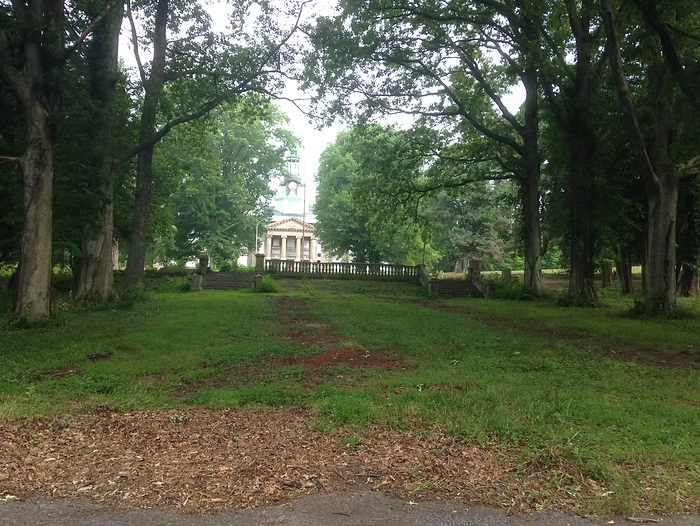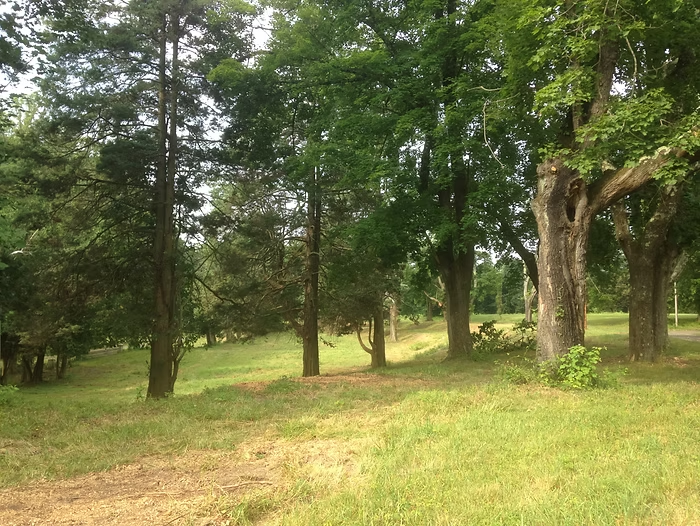PORT DEPOSIT — Erika Quesenbery-Sturgill woke up on Sept. 21 to a cell phone buzzing with text messages, voicemails and emails waiting for her reply.
While the noted local historian knew immediately that something was amiss so early on a Sunday morning, she had no idea the extent of the bad news. For more than two decades, Quesenbery-Sturgill has studied and shared the history of Bainbridge, a tract of land atop the granite cliffs above Port Deposit that served as home to the Tome School for Boys and a U.S. Naval Training Center, even publishing a book on it.
What all of her colleagues were trying to tell her was that Memorial Hall, the prized Tome School structure that later served as a central gathering place for the Naval Academy Preparatory School, had been devastatingly damaged by a fire. Lying in disrepair after the Navy officially left in 1986 — and further damaged by a stretch of use by the U.S. Department of Labor Job Corps until 1990 — Memorial Hall was already in poor shape. After the fire, it may be too late to save much of the structure.
“Piece-by-piece, year-by-year, we’ve lost parts of the property’s legacy,” Quesenbery-Sturgill said. “With the fire, it’s been put into hyperdrive. It rips your soul out.”
The 50-foot-by-100-foot, stone and mortar building was originally constructed in 1901 at the Tome School for Boys, a prep school with a list of distinguished graduates that includes R.J. Reyolds, Jr., son of the cigarette mogul, and members of Mellon and Carnegie families.
Memorial Hall was the main classroom building for the Tome School for Boys. Built entirely of Port Deposit granite with dressed Indiana limestone, it was state-of-the-art when it opened after a rushed and impressive construction phase of only two years.
It was one of the first buildings started at the campus on the bluff above Port Deposit — the other two being the headmaster’s house and the Tome Inn, which was also known as the Chesapeake Inn and Van Buren House.
Memorial Hall was dedicated in honor of lumber-and-railroad tycoon Jacob Tome as a lasting memory to him, for it was his largesse that allowed the school to be erected after he founded the free school known as Jacob Tome Institute in Port Deposit. Unfortunately, he never personally saw the beautiful building built in his honor as he died in March 1898.
Memorial Hall housed school offices, all of the classrooms, shop classes in the basement, the school library, a 500-seat auditorium and a chapel. Franklin D. Roosevelt, then undersecretary of the Navy prior to becoming president, was among those who spoke at the hall as a guest lecturer.
The building also boasted two sweeping curved staircases between the first and second floors with 32-arm chandeliers and columned architecture. The exterior walls were of dressed Port Deposit granite with an interior brick wall then a horse hair plaster interior wall. All of these materials were hauled up the hill to the construction site by horse-drawn wagons and carts.
The entire campus cost just under $1 million to build at the turn of the century.
Following the exodus of the Navy, the Susquehanna Job Corps Center operated inside some of the old Tome School buildings, but the abandoned base became a target for the ill-intentioned. At least six arsons and 12 fires were reported at the property in 1988 alone.
By 1990, the job corps moved out too, leaving all of the structures on the property ripe for theft and vandalism. Unfortunately, the stately looking Memorial Hall was a frequent target. Copper was the first element to be stripped from the buildings — presumably for scrap metal sale — and then just about anything else, Quesenbery-Sturgill said.
“Door knobs, roof shingles, adornments, toilets … just about anything not nailed down has been stolen through the years,” she said. “When there wasn’t anything left worth stealing, vandals would smash things or thrown radiators down the stairs, damaging our history.”
Most of the government-built buildings were demolished during a lengthy cleanup in the late 1990s. Later on, it was discovered that the demolition left contamination of the soil in many areas, and debates over the liability of that work are still continuing.
Quesenbery-Sturgill said that she became interested in Bainbridge in 1989, while working as a radio station reporter covering a proposal to build a NASCAR track at the property. Afterwards, she found herself drawn to the property, returning in 1997 with Delegate David Rudolph (D-Cecil) and then Cecil County District Court Judge Walter Buck, Jr., who was a 1940 Tome School graduate.
“We were walking the grounds during some event when I asked them why we couldn’t clean it up,” she recalled. “Dave told me that if I could round up a few folks, he’d get me the keys to the gate as a birthday gift. In the end, 50 people came out on my birthday for what would become the Tome School Clean-Up Volunteers.”
Every Saturday from May to October, the volunteers worked to clear brush, clean the buildings make small repairs on the property, Quesenbery-Sturgill said. Memorial Hall and its surrounding property were frequent targets of their efforts.
In 1999, special legislation passed by the Maryland General Assembly created the Bainbridge Development Corporation (BDC), composed of local volunteers, and tasked it with the redevelopment of the site. On Feb. 14, 2000, the federal government turned over ownership of the property to the State of Maryland and the BDC. Volunteers were then not allowed to work on the property under the new ownership.
Development plans crafted in 2004 heeded the plans that then County Commissioner Mary Maloney developed — mixed use development and job centers. Despite astronomical expense to preserve condemned historic structures at Tome School by Paul Risk Associates and artist renderings of developments, nothing has come to fruition 14 years later on the bricks and mortar side of development.
Port Deposit Mayor Wayne Tome was at Water Witch Volunteer Fire Company in the early morning hours of Sept. 21. As EMS chief for the company, he spends many nights on duty or just hanging around the station, but about 2:45 a.m. that morning, he was pressed into action close to home.
“A passerby saw flames and called 9-1-1,” Tome said. “The call originally came as a fire behind D’Lorenzo’s Pizza, which is just down the street from the station. We ran outside and could see the smoke rising in the sky. I knew it was something bad at Bainbridge.”
Tome got some of his first firefighting experiences battling the arsons of the late 1980s on the property, and was immediately drawn back to those memories when he arrived on scene of the Memorial Hall fire. Approximately 50 firefighters with volunteer fire companies from Perryville, Rising Sun, North East, as well as Harford County and southern Pennsylvania, responded to the scene, and it took three hours to bring the blaze under control.
“It was very disheartening to see such needless damage,” Tome said. “There has to be millions of dollars in damage in this fire.”
Deputy State Fire Marshal Derek Chapman said that investigators have not yet determined a cause or origin of the fire, because hotspots still cause occasional flare-ups on the property. Until investigators can safely work through the enormous structure, few conclusions will be able to be drawn, he said.
“There are collapse zones with several floors, which makes it dangerous to be in the building for very long,” he said. “Its age and make-up makes it a very tricky structure. We’ll need engineers to aid us in the investigation.”
While no determination of cause has been made, officials noted that Memorial Hall has no working utilities that could have sparked a fire.
Mike Pugh, chairman of the Bainbridge Development Corporation, said that Memorial Hall was always intended to be restored in some fashion. Now they are awaiting a chance to enter what is left to assess the structure.
“Memorial Hall is the centerpiece of the Tome School campus, it could be seen from a great distance,” he said, declining to note an assessed value for the building. “This is obviously a setback, but we remain committed to finding a path to restore the whole property.”
Pugh said that the BDC continues to work toward a multi-faceted development of the property, with industrial/commercial taking root on the old naval training center. While the corporation’s request for proposals last year didn’t bear any fruit, they did receive good feedback, Pugh said. The lack of water and sewer infrastructure continues to hamstring development interest.
“The redevelopment of the entire site and the Tome School campus may not be linked,” he said. “We could redevelop in portions.”
Quesenbery-Sturgill said that the fire may have had one unintended benefit.
“Out of the ashes, it has created a renewed interest in the property and discussion about its future,” she said. “Community participation and interest is an essential part to redevelopment.”
While Memorial Hall may still be saved, it could only be a shell of its former self, Quesenbery-Sturgill said.
“Most historians, especially preservationists, will tell you that it is never beyond repair,” she said. “It may still be able to be a shell, especially with the strength of the granite, with some adaptive reuse, but the original element is gone. There was very little left before the fire, but now even that is gone.”
Quesenbery-Sturgill noted that Jackson Hall, another Tome School property, sustained heavy damage in a fire decades ago, but still stands today without interior walls. The cost of restoring Memorial Hall to its original condition or even a replication of it would be staggering though, she added.
Perhaps the biggest loss in her opinion, however, is that Cecil County has no other building of such size, scope and magnitude with such historic importance.
“Memorial Hall was designed by William A. Boring and Edwin L. Tilton, the same New York architects that designed the U.S. Immigration Station on Ellis Island. We have no other Boring and Tilton buildings,” she said. “Other areas of the country have societies dedicated to protecting the work of those architects.”
Pugh said that he could remember the sailors and students coming through Bainbridge and Port Deposit when he was a child. It was a bustling sea of people and resources constantly coming and going, he recalled.
“It was a city unto itself and now to see it come to this, it’s a sad story,” he said. “This fire is just the continuation of the sad Bainbridge story.”








